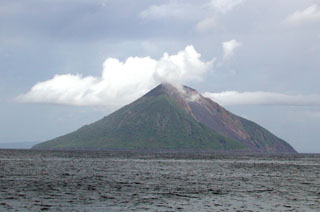Report on Tinakula (Solomon Islands) — 25 October-31 October 2017
Smithsonian Institution / US Geological Survey
Weekly Volcanic Activity Report, 25 October-31 October 2017
Managing Editor: Sally Sennert.
Please cite this report as:
Global Volcanism Program, 2017. Report on Tinakula (Solomon Islands) (Sennert, S, ed.). Weekly Volcanic Activity Report, 25 October-31 October 2017. Smithsonian Institution and US Geological Survey.
Tinakula
Solomon Islands
10.386°S, 165.804°E; summit elev. 796 m
All times are local (unless otherwise noted)
Based on satellite data and information from ground-based observers, the Wellington VAAC reported that during 25 October and the early part of 26 October a low-level eruption at Tinakula was ongoing. Ash emission rose 2.1 km (7,000 ft) a.s.l. and drifted S and SE. A news article from 1 November noted that significant ashfall had covered crops, and the water supplies for an estimated 11,500 people had been contaminated.
Geological Summary. The small 3.5-km-wide island of Tinakula is the exposed summit of a massive stratovolcano at the NW end of the Santa Cruz islands. It has a breached summit crater that extends from the summit to below sea level. Landslides enlarged this scarp in 1965, creating an embayment on the NW coast. The Mendana cone is located on the SE side. The dominantly andesitic volcano has frequently been observed in eruption since the era of Spanish exploration began in 1595. In about 1840, an explosive eruption apparently produced pyroclastic flows that swept all sides of the island, killing its inhabitants. Recorded eruptions have frequently originated from a cone constructed within the large breached crater. These have left the upper flanks and the steep apron of lava flows and volcaniclastic debris within the breach unvegetated.
Sources: Wellington Volcanic Ash Advisory Center (VAAC), Radio New Zealand

